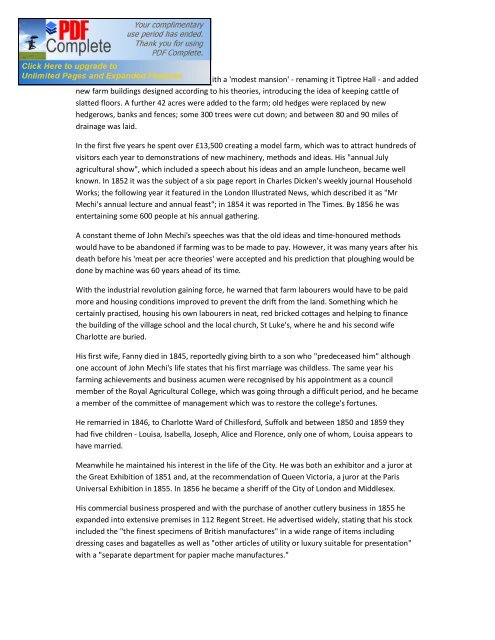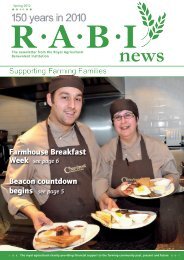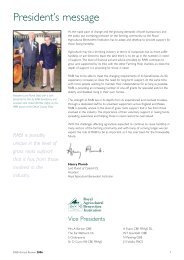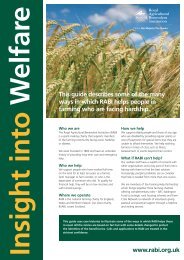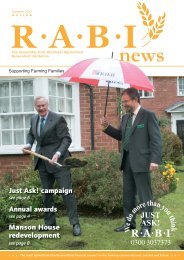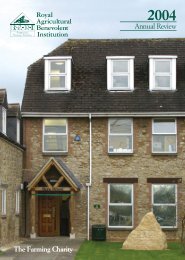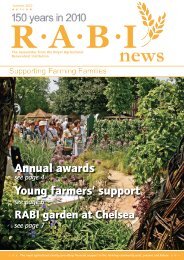The First 150 Years of RABI Part 1 In the build up to our 150th ...
The First 150 Years of RABI Part 1 In the build up to our 150th ...
The First 150 Years of RABI Part 1 In the build up to our 150th ...
Create successful ePaper yourself
Turn your PDF publications into a flip-book with our unique Google optimized e-Paper software.
Tiptree Hall, EssexHe demolished <strong>the</strong> house, replacing it with a 'modest mansion' - renaming it Tiptree Hall - and addednew farm <strong>build</strong>ings designed according <strong>to</strong> his <strong>the</strong>ories, introducing <strong>the</strong> idea <strong>of</strong> keeping cattle <strong>of</strong>slatted floors. A fur<strong>the</strong>r 42 acres were added <strong>to</strong> <strong>the</strong> farm; old hedges were replaced by newhedgerows, banks and fences; some 300 trees were cut down; and between 80 and 90 miles <strong>of</strong>drainage was laid.<strong>In</strong> <strong>the</strong> first five years he spent over £13,500 creating a model farm, which was <strong>to</strong> attract hundreds <strong>of</strong>visi<strong>to</strong>rs each year <strong>to</strong> demonstrations <strong>of</strong> new machinery, methods and ideas. His "annual Julyagricultural show", which included a speech about his ideas and an ample luncheon, became wellknown. <strong>In</strong> 1852 it was <strong>the</strong> subject <strong>of</strong> a six page report in Charles Dicken's weekly j<strong>our</strong>nal HouseholdWorks; <strong>the</strong> following year it featured in <strong>the</strong> London Illustrated News, which described it as "MrMechi's annual lecture and annual feast"; in 1854 it was reported in <strong>The</strong> Times. By 1856 he wasentertaining some 600 people at his annual ga<strong>the</strong>ring.A constant <strong>the</strong>me <strong>of</strong> John Mechi's speeches was that <strong>the</strong> old ideas and time-hon<strong>our</strong>ed methodswould have <strong>to</strong> be abandoned if farming was <strong>to</strong> be made <strong>to</strong> pay. However, it was many years after hisdeath before his 'meat per acre <strong>the</strong>ories' were accepted and his prediction that ploughing would bedone by machine was 60 years ahead <strong>of</strong> its time.With <strong>the</strong> industrial revolution gaining force, he warned that farm lab<strong>our</strong>ers would have <strong>to</strong> be paidmore and housing conditions improved <strong>to</strong> prevent <strong>the</strong> drift from <strong>the</strong> land. Something which hecertainly practised, housing his own lab<strong>our</strong>ers in neat, red bricked cottages and helping <strong>to</strong> finance<strong>the</strong> <strong>build</strong>ing <strong>of</strong> <strong>the</strong> village school and <strong>the</strong> local church, St Luke's, where he and his second wifeCharlotte are buried.His first wife, Fanny died in 1845, reportedly giving birth <strong>to</strong> a son who "predeceased him" althoughone account <strong>of</strong> John Mechi's life states that his first marriage was childless. <strong>The</strong> same year hisfarming achievements and business acumen were recognised by his appointment as a councilmember <strong>of</strong> <strong>the</strong> Royal Agricultural College, which was going through a difficult period, and he becamea member <strong>of</strong> <strong>the</strong> committee <strong>of</strong> management which was <strong>to</strong> res<strong>to</strong>re <strong>the</strong> college's fortunes.He remarried in 1846, <strong>to</strong> Charlotte Ward <strong>of</strong> Chillesford, Suffolk and between 1850 and 1859 <strong>the</strong>yhad five children - Louisa, Isabella, Joseph, Alice and Florence, only one <strong>of</strong> whom, Louisa appears <strong>to</strong>have married.Meanwhile he maintained his interest in <strong>the</strong> life <strong>of</strong> <strong>the</strong> City. He was both an exhibi<strong>to</strong>r and a juror at<strong>the</strong> Great Exhibition <strong>of</strong> 1851 and, at <strong>the</strong> recommendation <strong>of</strong> Queen Vic<strong>to</strong>ria, a juror at <strong>the</strong> ParisUniversal Exhibition in 1855. <strong>In</strong> 1856 he became a sheriff <strong>of</strong> <strong>the</strong> City <strong>of</strong> London and Middlesex.His commercial business prospered and with <strong>the</strong> purchase <strong>of</strong> ano<strong>the</strong>r cutlery business in 1855 heexpanded in<strong>to</strong> extensive premises in 112 Regent Street. He advertised widely, stating that his s<strong>to</strong>ckincluded <strong>the</strong> "<strong>the</strong> finest specimens <strong>of</strong> British manufactures" in a wide range <strong>of</strong> items includingdressing cases and bagatelles as well as "o<strong>the</strong>r articles <strong>of</strong> utility or luxury suitable for presentation"with a "separate department for papier mache manufactures."


